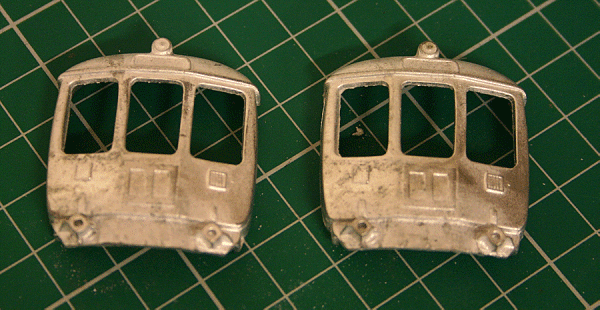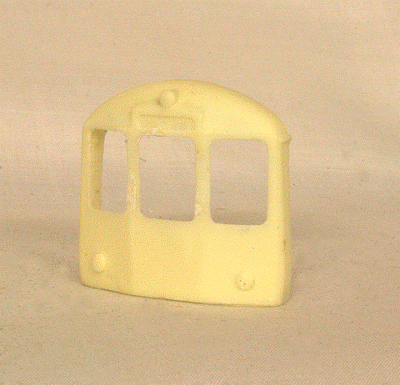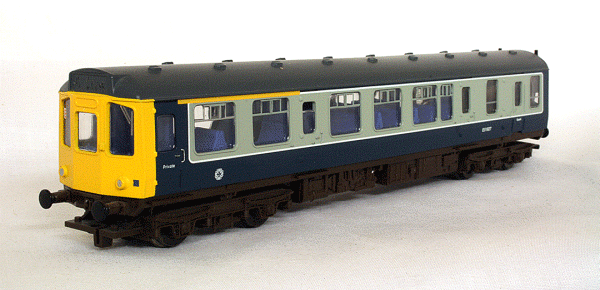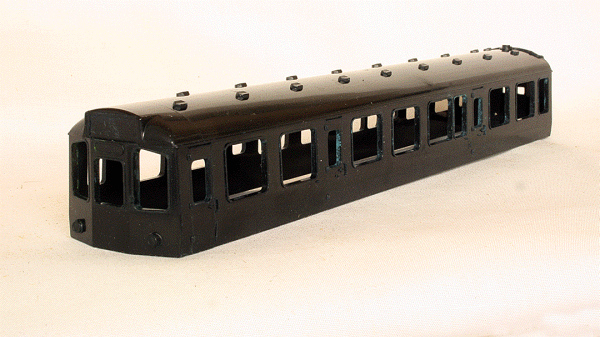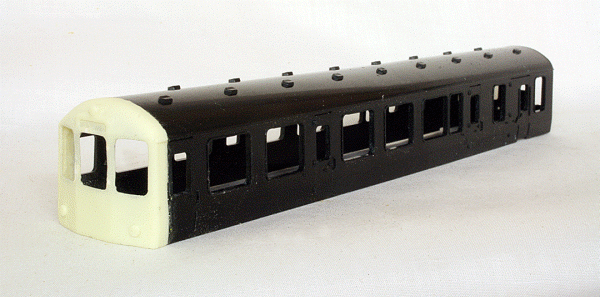Steve Johnson Modelmaker
|
|
Class 104 Birmingham RCW The Birmingham Railway and Carriage Works Class 104 was the largest number non-BR built DMU from the Modernisation Plan. Built in 1957 they were designed for commuter and branch line service. They appeared in 2, 3 and 4 car sets with six variations in vehicle types. These were DMBS, DMCL, DTCL, TCL, TSL and TBSL. There was also some variation in front end design, some driving cars having centre top light. They are associated mainly with services in the North-West, particularly the Manchester-Buxton route. However, they also operated in the North-East, Midlands, Scotland and London. The last were finally withdrawn in 1995. Needless to say, with six vehicle types, different front ends and numerous liveries from BR Green to Network Southeast to 'Mexican Bean', not to mention various modifications over the years (i.e. headcode panels) careful study is needed to get an accurate version. So, the Birmingham RCW Class 104 is one of those iconic First Generation DMU's I wanted to build. I came across some cast cab ends being sold by Phoenix Precision a while ago and bought them. They are the old MTK/No Nonsense Kits castings. However, they looked as though they will clean up well enough. Etched sides can be obtained from Worsley Works, so that just left a roof and chassis.
Phoenix Precision Cast Cabs Before I made a start, I came across some further cab ends, this time produced by Silver Fox. They looked a bit better to me and are designed to fit the Hornby Class 110 DMU, which would serve as a suitable donor vehicle. So a pair of these were acquired, along with a used Hornby Class 110 DMU as a donor.
Silver Fox cab end
Hornby Class 110 as a donor vehicle Now, as usual, as soon as I had acquired the parts to build a Class 104, Heljan announced that they were going to produce a RTR version! However, in view of the somewhat extortionate prices charged by some manufacturers for 3 car DMU's, I thought I would continue with my build as it will suit my needs. I'm sure the Heljan version will be an excellent model in every way for those happy to pay the price (estimated £240 in early 2021). First thing to do is to take the model apart, remove the window glazing (and save for refitting) and strip the paint. I thought I would try something new here and use Dettol! Yes, Dettol disinfectant! Apparently, it is very good as a model paint stripper and considerably cheaper than commercial paint strippers aimed at modellers. The Dettol did work, but took about five days to do the job.
Class 110 body after paint stripping in Dettol With a clean bodyshell, I thought I would chop off the old cab and replace it with the new Class 104 cab. This would help me get a better idea of the overall look of the conversion.
The Hornby DMBSO with the Silver Fox cab attached It was now time to investigate a little further with what needed to be done. There are a few differences between a Class 110 and Class 104. The first and most obvious are the window frames. The class 104 does not have these and so, they had to be removed. This was done by carefully using a sharp scalpel blade. The rest relates to Hornby's rendition of the bodyshell. Most noticeable is the tumblehome. Hornby had chosen to model the tumblehome with a sharp angle, rather than a curve. So out with the file to take off the 'peak' and some gentle smoothing with fine wet and dry abrasive paper. I also decided to remove the door grab handles, door handles and handrails. The bump stops were left. The handrails will be replaced by separate wire and the grab and door handles replaced by etched versions by MJT. The water filler pipes at the carriage ends will also be replaced with separate wire fittings. The three Hornby Class 110 vehicles are a E52080 (DMCL), E59808 (TSL) and E51827 (DMBC). For a 3 car Class 104, these need to be a DMCL, TCL and DMBS. Fortunately, the bodies are all
Silver Fox Models offer a RTR version of this class in 3 or 4 car sets. Craftsman Models produced a conversion kit based on the Hornby Class 110. MTK also offered a kit (MU04) of this class. Heljan announced in early November 2020 their intention to produce a model of the Class 104. They are intending to cover most versions and it will feature a 'low profile' mechanism.
|
